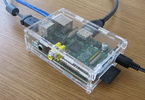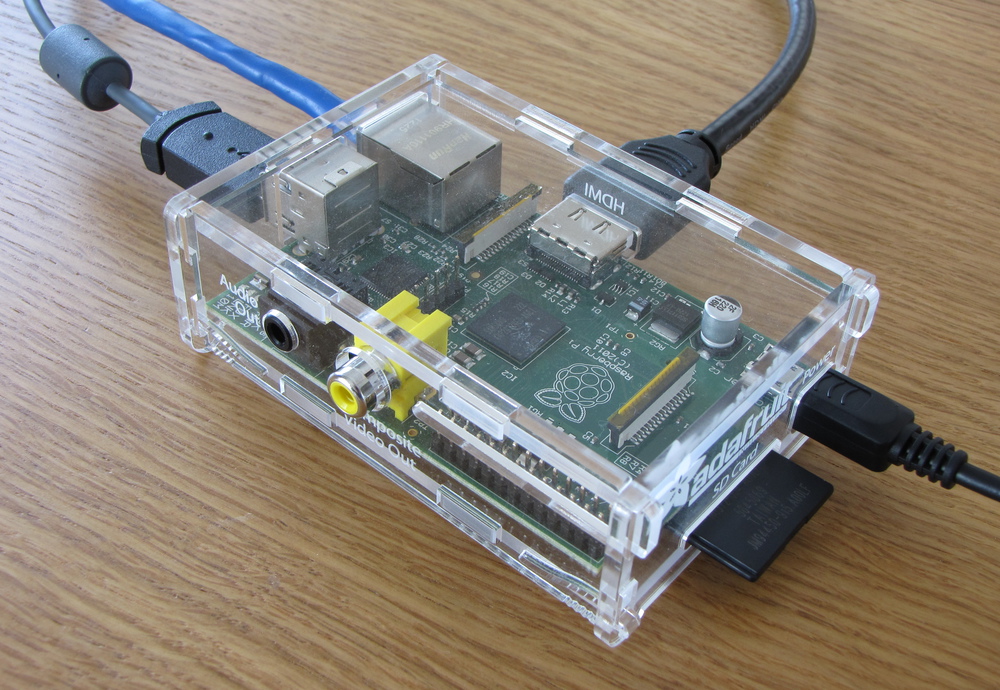Raspberry Pi

I received my Raspberry Pi at the beginning of August 2012. The photo below shows it in the nice looking Adafruit case - the joints aren't entirely snug, but it holds together well and looks great. After more use though I've found it intensely annoying as it's slow to open and close, and extremely difficult to access the I/O pins if you're not using the ribbon cable the case manufacturers apparently expect. Also shown are all the usual fittings I use it with: USB, ethernet, HDMI, microUSB power connector, and SD card.
The official Linux distro for the Raspberry Pi, and the one I've chosen to install, is Raspbian. It boots up exactly like Debian on a desktop system, including going to a text console if you prefer that (I do) - something I don't think any of the mk802 distros are capable of.
apt-get installs are agonizingly slow compared to a standard computer, but that's no different from the mk802. I haven't tried running a video on it, but word is that works exceptionally well. UPDATE: no, it's awful. Apparently Raspbian is running framebuffer (and thus unaccelerated), apparently they don't supply the video driver blob yet for some reason. It is, after all, based on Debian with its anti-proprietary attitudes.
Weird, weird resolutions: on a 24" Samsung it runs at 1824x984, on a 23" Acer it runs at 1584x954. Both with enormous thick black borders.
I've had a LOT of problems with mouse and keyboard: right-click works fine, but left-click and click-and-drag often require multiple (and I mean up-to-ten) attempts - most of the time the mouse clicks are simply ignored. With the keyboard, I've had problems with periods of a few seconds when all keypresses are ignored. This happens every five minutes. But worse is the sticky keys: a key will repeat about 20 times. This is NOT a problem with the keyboard, it's a good keyboard that works fine on other computers. So this takes us to an already notorious problem with the Pi: its weird power requirements and underpowered USB ports. The official USB standard calls for 100 mA available, with up to 500 mA available after (electronic) negotiation. But de facto usage has been that 500 mA will always be available. In this case, the Pi has honoured the letter of the law, not the practice, and only provides 100 mA. Better use a powered USB hub (I am). And using an inadequate power supply (one that supplies less than 700mA) has been known to cause frequent USB drop-out/reconnect cycles. I've tried a couple power supplies (both of which are listed as supplying enough power), and the behaviour is the same.
GPIO Pin-outs
(from the pi blog)
NOTE!!: This is for the Raspberry Pi v1. The pin layout is different for the v2: if you have a v2 go look it up!
NOTE 2!!: Other pin-out diagrams on the web all seem to vary in opinions on what number GPIO is where. Use at your own risk.
| 3V3 | 1 | 2 | 5V0 |
| SDA0 | 3 | 4 | DNC |
| SCL0 | 5 | 6 | GND |
| GPIO7 | 7 | 8 | TXD |
| DNC | 9 | 10 | RXD |
| GPIO0 | 11 | 12 | GPIO1 |
| GPIO2 | 13 | 14 | DNC |
| GPIO3 | 15 | 16 | GPIO4 |
| DNC | 17 | 18 | GPIO5 |
| SPI_MOSI | 19 | 20 | DNC |
| SPI_MISO | 21 | 22 | GPIO6 |
| SPI_SCLK | 23 | 24 | SPI_CE0_N |
| DNC | 25 | 26 | SPI_CE1_N |
